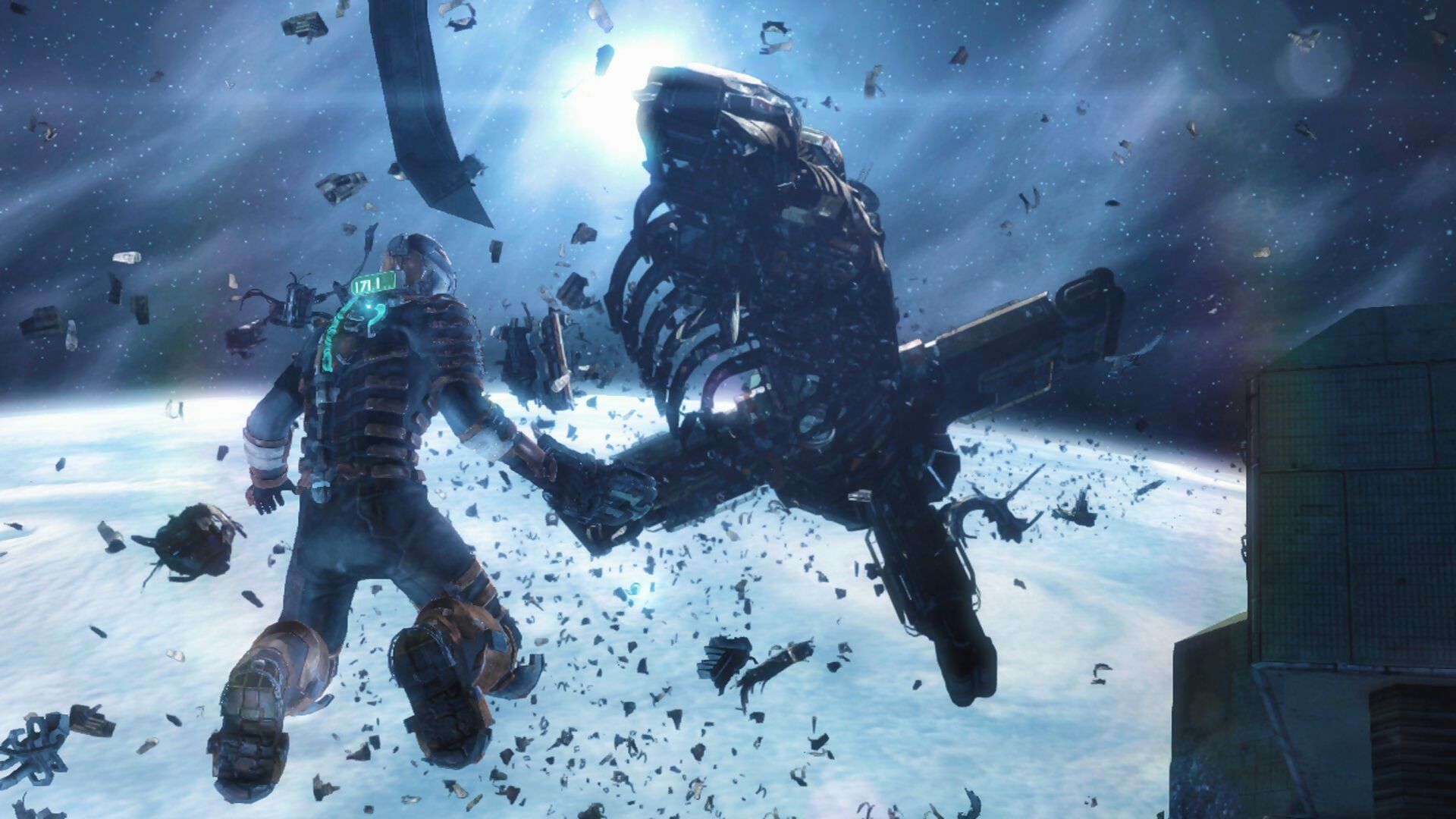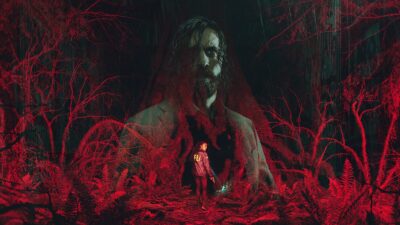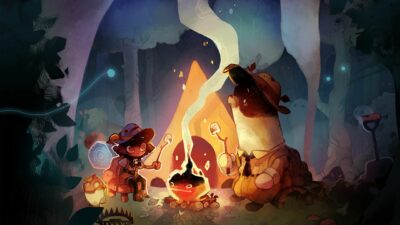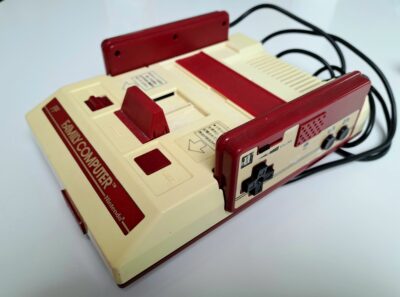
Dead Space has consistently chilled and thrilled players over the past 15 years. Graeme chats to its creators to uncover the series’ fascinating story.
From the first moment that a pair of disembodied eyes explored the spooky rooms of Atari’s Haunted House, game designers have sought to frighten, intimidate, and downright terrify gamers. That most primal of emotions, fear, has been a frequently tapped well throughout gaming history, and its origins, as with all horror, are the campfire ghost tales that people tell each other to while away the cool nights. The basis of all these tales is usually an oft-used core idea or concept: a dilapidated haunted house, a mutilated hitch-hiker, a 1000-year-old bloodsucking vampire. The Dead Space series, forged within the walls of EA Redwood Shores in the mid-Noughties, starts the same way.
“Unquestionably, Glen [Schofield] was the whole raison d’etre for Dead Space,” begins producer Chuck Beaver. “If it wasn’t for Glen, it wouldn’t have happened, for sure.” Schofield’s idea, forged by a lifetime of scary movies, games, and television, was for an intense horror game set, unusually for the genre, in space. “Most of the team were big horror fans,” continues Beaver. “The key IPs for all of us were Alien and Event Horizon. He loved the nature of the horror in Event Horizon.”
In the 1997 movie, a rescue mission goes horribly wrong, the crew of the eponymous craft sent insane due to its proximity to a hellish alternate dimension. “[Event Horizon] had a good mix of hellscape and gore,” recalls Ben Wanat, Dead Space’s production designer. “It was definitely the most contemporary influence at the time closest to our vision.”

The USG Kellion approaches the USG Ishimura in the original Dead Space.
It wasn’t just movies that influenced Dead Space’s concept; games played a part too, and one notable one in particular. “To help us stand up from nothing, we were initially designing ‘Resident Evil 4 in space’,” says Beaver. “And then, after we got there, we found our own identity.”
Dead Space’s grisly beginnings
Armed with the concept, Schofield pitched to Electronic Arts, proposing a brand new IP. Surprisingly, the suits were receptive, giving him the budget for an 18-person team and six months to develop a workable demonstration. That demo, or vertical slice, proved critical.
“That’s almost completely the reason we got greenlit,” smiles Beaver. “Because we did a very thick and detailed vertical slice.” The crucial part of Dead Space would be its evocative story, yet in early development, this was very different from the final game, as Beaver recalls. “The setting in Glen’s head was about captured criminals on a moon who became evil spirits somehow. Then, along comes an innocent ship and uncorks it.”
The catchy title for this idea was Rancid Moon, and while the concept enthused Schofield, the story slowly shifted to the game we know today, incorporating features from Rancid Moon.

Dead Space begins in the year 2508, with the shuttle USG Kellion en route to the USG Ishimura, a mining ship and the pride of its owner, CEC. The planet-cracker class vessel has gone dark; on board the Kellion are Zach Hammond, Kendra Daniels, a brace of doomed corporals and an engineer, Isaac Clarke. Isaac’s profession would become a fundamental part of the Dead Space story. “From the beginning, he was what we called an everyman,” notes Beaver. “He was never going to be a super-soldier. We wanted Isaac to be on the back side of the power scale.”
Shortly after docking with the Ishimura, things take a turn for the horrific. With just Zach, Kendra, and Isaac surviving the initial onslaught, Dead Space is a fraught, claustrophobic, and terrifying journey where survival is the only aim. The enemies? The deformed and gruesome former crew of the Ishimura, transformed by the power of a mysterious object known as the Marker. As with many of Dead Space’s notable elements, much of the credit for the hideous Necromorphs goes to designer and horror fan, Ben Wanat. “They’re influenced mostly by John Carpenter’s The Thing,” he says. “But I’m guessing that they were an influence for some of the more unusual transformations in Resident Evil 4, too.”
Creature feature
As in Carpenter’s classic 1982 movie, Dead Space’s Necromorphs are terrifying because of their similarity to the human form. Tentacles form from intestines, and broken bones jut outwards at unnatural angles. Yet the origin of these poor, tormented souls is clear. “It was about imagining different ways, uncomfortable ways of getting broken – and what would be strange to see running at you down the hallway,” wrote Wanat in Martin Robinson’s excellent book, The Art of Dead Space. Wanat was responsible for the concept of the initial 3D sculpts for the majority of Dead Space’s hideous enemies. “It was necessary to establish what the Necromorphs looked like, how their ecology worked, and how to realise those ideas into working 3D pre-vis models. I would rig these, animate, and render them to show people how I wanted them to feel.”
Informing each creature’s design was its silhouette, and using this aspect to scare the player even more. “We had such an incredibly strong focus of what the game was going to be from the very beginning – to make one of the scariest games ever,” says Beaver. “And one of the things we discussed was how to get past the jump scares. And the big pillars for horror are believability and immersion.”

Dead Space 2 introduces bigger and tougher opponents.
These two concepts materialise in two forms. First, the location of Dead Space, while obviously sci-fi and futuristic, is pared down: the Ishimura is a working ship, akin to the Nostromo from Alien, featuring angular corridors, dangerous-looking machinery, and loud, clanking equipment. “The emotional impact can get neutered if everything’s fantastical,” notes Beaver. “So you have this giant through-line of relatability and emotional targets to go with the world-building.” Much of the design of the Ishimura, which echoes the rib scripture on Isaac’s suit, or the dark, jutted corners that throw disturbing shadows, reflects this. The Necromorph’s use of air ducts emphasises more the connection to Alien and the latent fear of nasty things jumping out of the wall and grabbing you. The weapons Isaac discovers reinforce this believability: the plasma cutter, line gun, contact beam. It’s all mining equipment repurposed as lethal ordnance.
Second is Dead Space’s immersion, which begins with the holographic display that serves as Isaac’s inventory and interface with the world. “When it came to the UI, our art director [Ian Milham] put together a mock-up of the UI screen of a typical horror game,” remembers Beaver. “There was all this stuff on screen, and he cleared it off and said, ‘What if it looked cinematic?’. Glen already had some ideas; he was toying with the suit’s spine as a health indicator. So we thought we should consider going diegetic with our UI.” Already knee-deep in designing the shambling Necromorphs, Ben Wanat went home one Friday with a plan in his head. “I had started peppering holograms around demo spaces, and I wanted them to be interactive,” he explains. “And that eventually led to the interactive versions for doors and the inventory.” Isaac’s glowing inventory display hovers in front of him, moving around the environment as the player moves the engineer. In true devotion to the immersion belief, browsing through your items doesn’t pause the game – Isaac is constantly exposed to attack. “It wouldn’t pause the game because that’s where you can make some fourth-wall-breaking inventory decisions that aren’t true to the real-time run of the game. You had to go to a dark corner and make sure your weapons were loaded,” grins Beaver. The decision to fully immerse the player in Dead Space’s world did, however, result in one significant dispute – and one of the few major criticisms commonly levelled at the game.
“Gordon Freeman can get away with being a mute witness because we’re viewing events through his eyes,” wrote Dan Whitehead in his Eurogamer review of Dead Space. “Isaac, by comparison, acts like an emotionless automaton, even when faced with the most horrific sights.” Unbeknown to Whitehead and the majority of reviewers, the concept had caused an inordinate amount of discussion at both EA and Redwood Shores. “There were a lot of dead bodies at EA fighting over this,” chuckles Beaver. “It was a contentious point because people are religious about it – they think voiceless protagonists are unquestionably the only way to go.”

In the series, the Marker plagues Isaac with visions of his dead girlfriend, Nicole.
Blood born
The theory’s understandable: how can a player relate to an on-screen avatar if a voice constantly reminds them that this is a character and not them? As a writer, Beaver found the idea particularly difficult. “It was like, ‘Hey, we need you to make a property, but your protagonist is inexplicably mute’. And I said, ‘Is there a story why he’s mute?’ Nope. He just is.” Throughout the first Dead Space, Isaac stomps around the Ishimura, collecting items and performing tasks at the behest of the other survivors, Kendra Daniels and Zach Hammond. “He could never say ‘I should go fix the engines’,” muses Beaver. “It was always ‘Isaac, do the following things’. If he could talk, we could have swapped all that agency around instantly.” The team, says Beaver, was split equally on the concept. The final decision fell to Dead Space’s creative director, Glen Schofield. Isaac would be mysteriously silent.
While the team at Redwood Shores knew they had a great concept, the success of Dead Space still caught many by surprise. “We put our heart and soul into that game, and it was as good as we’d hoped,” recalls Beaver. When EA greenlit a sequel shortly after release, it triggered a tumultuous time for the developer, by now called Visceral. With more or less the same team in place, the sequel’s development proceeded for almost a year. “Then, Glen [Schofield] left to form Sledgehammer and took half the team with it,” remembers Beaver. “Those guys were family – still are.”
With EA and Visceral feeling the aftershocks of the upheaval, development continued, and the result – Dead Space 2 – is widely considered one of the greatest sequels of its generation. Ben Wanat recalls how he coped and even turned the change into a positive. “It was tough to see so many people leaving at once. But I’ve always been so focused on making the game that I couldn’t really let it slow me down. And sometimes I think we get used to working with the same people – I’ve learned it’s a great idea to shake things up, make room for other voices, and you often uncover new ideas you wouldn’t have come up with otherwise.” The mix of new and old blood engendered new ideas. “We were able to make decisions quicker and make the game faster,” recalls Beaver. “The first half of Dead Space 2 was probably the worst professional experience of my life; the second half, the best.”
Beaver and Wanat found themselves in control of Dead Space’s lore and story, and tweaked the gameplay in several new directions. Gone were the hard cuts between levels where Isaac travels to his next destination on the tram system, resulting in the game becoming one single shot from start to finish. In addition, Isaac’s stasis and telekinesis abilities are nimbler, his suit has gained rocket boots, making zero-G movement more fluid, and the engineer finally has a voice, able to talk and even joke with his colleagues and enemies. Behind the scenes, fresh team members mixed with existing personnel, such as Wanat, fully embracing his production designer role. In addition to working with the game’s art designers, he was now directly involved with the story. “We needed to decide where it should take place, what had become of Isaac, and so on. And that stretched from the beginning, through the employee exodus and project restart, all the way to ship and DLC.”
Sequel syndrome
And what a story. It’s three years after the traumatic events of Dead Space. Isaac Clarke is on The Sprawl, a vast space station lurking on the remains of the Saturn moon, Titan. In the game’s stressful opening, an investigator interrogates Isaac, desperate to learn what he knows about the outbreak on Aegis VII and the mysterious alien artefact from the first game, the Marker. Haunted by the suicide of his girlfriend, Nicole, and anxiously fending off the insidious mental grip of the alien object, Isaac first has to escape a straitjacket before battling another Marker-inspired Necromorph outbreak. Storyboarding was helpful, as Wanat explains. “It started with us knowing that we needed a certain number of big moments. We doled them out, [according to] chapters, and explored what they could be based on [considering] where that chapter took place and the story at the time.”
The skeleton of each moment was assigned a pod of devs who submitted weekly revisions and progress to the production team. The most notorious of these moments occurs towards the end of the game, as Isaac enters a machine that will unblock the Marker-infected parts of his tormented mind. “We’d been torturing Isaac a thousand ways at this point,” laughs Beaver. “And we were like, ‘What else can we do?’” The scene derived from one simple precept: the universal fear of eye trauma. “The whole thing rose from the idea of poking your eye out. Everyone is squeamish about that, so we added a needle, heartbeat, and his rapidly moving eye. It was brilliant, and the team loved it.”

Sales of Dead Space 2 were solid rather than spectacular, despite a firmer promotional push from EA. “I think we all knew we had something we were proud of,” recalls Wanat. “But also, my dev brain saw many things that could have been polished better with more time. And it was hard to tell how fans would take the control revisions and action-movement focus. But yeah, it was definitely our Aliens follow-up to Alien.” Despite critical acclaim, the pressure was on to elevate the sales of the Dead Space games to a higher tier, as Beaver explains. “The intent was that the franchise would become much larger in terms of sales, and that trend was not evident in Dead Space 2. So when it came to Dead Space 3, we had to make this change evident and sell more.”
In Dead Space 3, Isaac tracks his ex-girlfriend Ellie to the ice planet Tau Volantis, the source of a new Marker signal, followed by the Inner Circle, a fanatical subdivision of the Church Of Unitology. Once there, he discovers evidence of an ancient alien species and its attempt to prevent a Marker convergence event by freezing the previously ocean world of Tau Volantis. The battle between the Inner Circle and Isaac’s team culminates with the nearby Necromorph moon plummeting into the planet, destroying itself and the Markers. Back in our world, EA decided that the game should focus on action rather than horror. “They concluded that the main reason people played Dead Space was because it’s a horror game,” explains Beaver. “And that the main reason people didn’t play Dead Space was because… it’s a horror game.”
Beyond horror
The idea of a broader audience brought in more fresh elements. Weapon crafting, cover mechanics, dodge, and co-op play were all included, the latter partway into development. “But all of that stuff was in service of trying to make better sales without using the equity that we had in IP,” notes Beaver. Moreover, Visceral had already bowed to pressure by including a PvP mode in Dead Space 2; no one was keen to repeat that experience for the third game. “We had experimented with co-op play on the first game,” reveals Wanat, “but found it incompatible with the tech realities of how the game content was authored.” Intriguingly, an early draft of co-op had Isaac’s shadow as a companion, accentuating his fragile mental state. Ultimately, the second character became a beefy soldier named Carver, ostensibly catering to shooter fans.

A moment for reflection as Isaac watches the sun set over a Marker.
None of these new elements were bad ideas. But in combination with the tonal shift and human enemies, it created something too different from what people loved about the series. “We trundled down that path, and when we got focus-tested, people were like, ‘This is real fun, but where’s my Dead Space?’,” remembers Beaver. The team added more horror to some of Dead Space 3’s encounters, but the damage had been done. Along with the controversial addition of micro-transactions, the DNA of Dead Space, like its shambling villains, had been irrevocably changed. Furthermore, when a rumour surfaced that there was unlikely to be a Dead Space 4, the storyline had to be hastily adapted to bring the series to an abrupt conclusion. “It meant our story was just too big and complex for the game,” recalls Wanat. “The more exposition you do that doesn’t involve the player’s input, the more you risk losing the player’s interest.”
Dead Space 3’s sales were comparable to its predecessor, but the rumours were indeed true: there would be no Dead Space 4. “The whole business model of a single-player narrative game was under extreme stress,” notes Beaver. “And it finally caught up with us in Dead Space 3.” At the end of the third game’s development, Visceral did some nominal work on its sequel, but Dead Space 4 was never more than a rough story outline. “Ben [Wanat] wanted Dead Space 4 to be Ellie’s adventure,” remembers Beaver. “There was also this idea that Isaac would become a herald of the Marker, reanimated and sent back to Earth.”
As we wait for the arrival of EA’s Dead Space remake and Glen Schofield’s spiritual sequel, The Callisto Protocol, it’s clear that the love for the original series remains strong today. “I’m always a bit tickled and surprised when a fan reaches out to proclaim their love of the franchise,” says Wanat. Blessed with constructing a new IP and a cohesive and talented team, Visceral had the vision and prowess to deliver a fantastic experience for horror fans. “There’s nothing like the full flow of the creative process, and we had it for those games,” concludes Beaver. “I didn’t know it at the time, but now I know how incredibly special that was.





